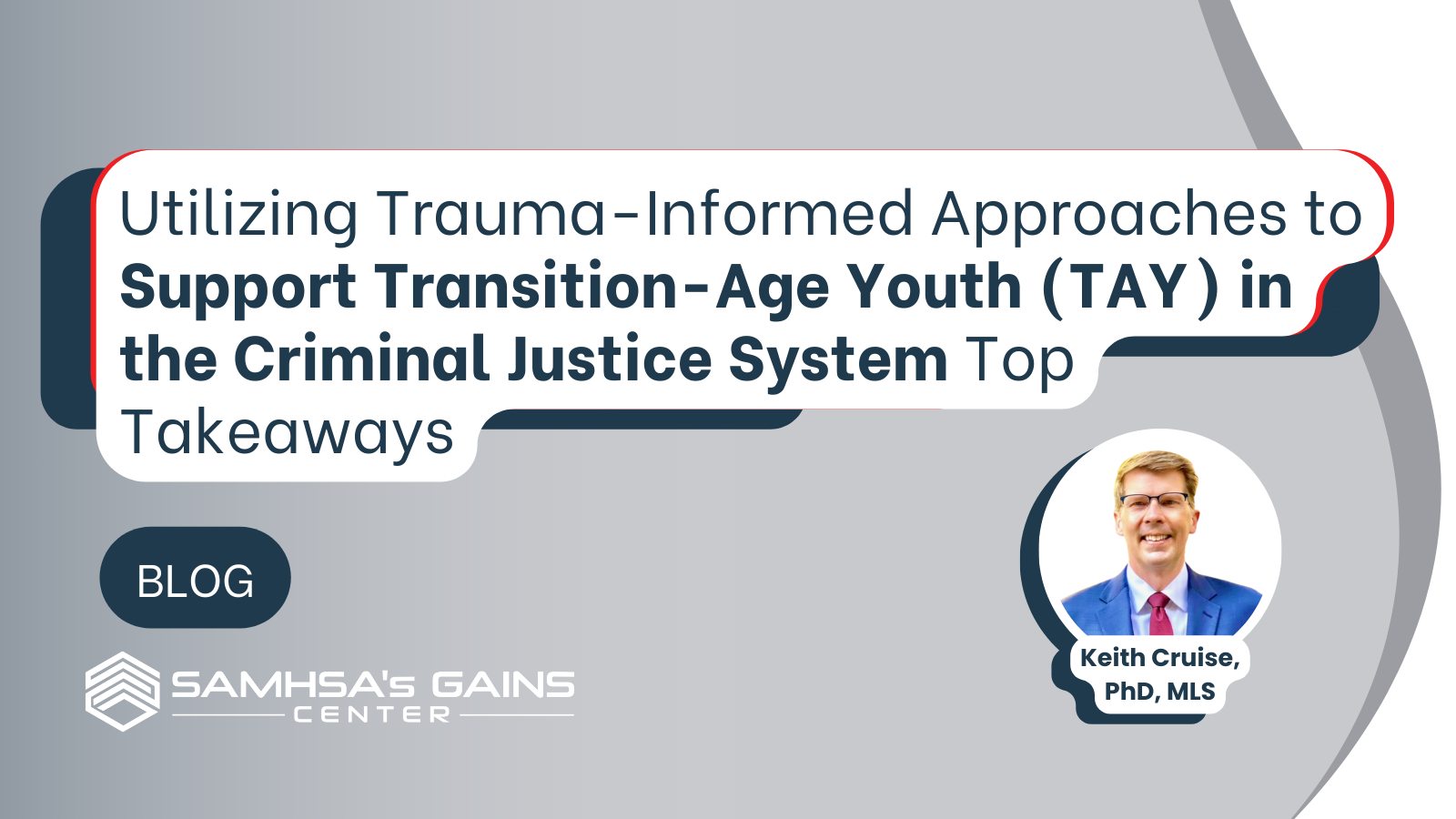In the transition from adolescence to adulthood, individuals aged 18-24 can face significant challenges. Their brains are still maturing, and many are dealing with the responsibilities of adulthood without adequate support. This demographic—especially those experiencing mental health conditions, substance use disorders, or a history of trauma—is at a heightened risk of negative outcomes when involved in the criminal legal system. Addressing these issues through trauma-informed approaches is crucial for their well-being, especially in the context of the criminal legal system.
SAMHSA’s GAINS Center recently hosted a webinar titled “Utilizing Trauma-Informed Approaches to Support Transition-Age Youth in the Criminal Justice System.” The webinar, featuring Dr. Keith Cruise, delved into principles of trauma-informed care and practical strategies for implementing these approaches. Read on below for essential takeaways from the webinar.
Q: Why is it important to consider brain development when working with transition-age youth in the criminal legal system?
A: The brain continues to develop into an individual’s mid-20s, particularly the prefrontal cortex, which governs impulse control and decision-making. Understanding this helps in recognizing that transition-age youth are not fully mature and may engage in risky behaviors without fully understanding the long-term consequences.
Q: What are the key characteristics specific to young adults that affect their behavior and legal culpability?
A: Research shows us that young adults exhibit heightened sensation-seeking behavior, poor judgment in high-stress situations, and are heavily influenced by their peers and family environment. These factors, combined with their ongoing brain development, may make them more susceptible to risky behaviors.
Q: How does trauma impact transition-age youth involved in the criminal legal system?
A: Trauma can severely impact the mental health and behavior of transition-age youth. Experiences of trauma, such as abuse or community violence, can lead to issues like PTSD, which in turn affect their decision-making and impulse control, increasing their risk of further system involvement.
Q: What are the principles of trauma-informed care mentioned in the webinar?
A: Trauma-informed care involves understanding the widespread impact of trauma, recognizing trauma’s signs and symptoms in individuals, integrating knowledge about trauma into policies and practices, and seeking to avoid re-traumatization. A trauma-informed approach helps create a supportive environment for youth.
Q: How can the Risk-Needs-Responsivity (RNR) model be integrated with trauma-informed care?
A: The RNR model focuses on assessing the risk of reoffending, identifying individual needs, and tailoring interventions to meet the person where they are. Integrating trauma-informed care means considering trauma as a key responsivity factor, ensuring that interventions also address the underlying trauma that affects behavior.
Q: Can you explain the concept of chronic survival coping and its relevance to this population?
A: Chronic survival coping refers to patterns of hypervigilance, reactive aggression, and hopelessness developed in response to prolonged trauma. These coping mechanisms can lead to difficulties in trust, goal-setting, and self-regulation, exacerbating the risk of negative outcomes in the criminal legal system.
Q: What strategies can be employed at the system level to support trauma-informed care?
A: Strategies include implementing universal trauma screening, providing comprehensive behavioral health assessments, and integrating trauma-informed policies and practices across all levels of the justice system. Staff training and support are also crucial in creating a trauma-informed environment.
Q: How does the Trauma-Informed Decision Protocol (TIDP) support case planning?
A: The TIDP helps integrate trauma screening and behavioral health assessments into case planning. It provides a structured approach to identify and address trauma-related needs, ensuring that interventions are tailored to support the youth’s overall well-being and reduce recidivism.
Q: What role do staff relationships play in a trauma-informed approach?
A: Staff relationships are pivotal. Staff should engage with youth in a respectful, caring, and collaborative manner, focusing on building trust and supporting autonomy. Effective staff relationships can facilitate positive behavior changes and improve outcomes for youth.
Q: What resources were highlighted for further learning and implementation of trauma-informed care?
A: Resources include the Trauma-Informed Juvenile Court Self-Assessment tool, Think Trauma training curriculum, and the TARGET model for building self-regulation skills. These resources support organizations in adopting and sustaining trauma-informed practices.
For more in-depth insights, watch the full webinar, linked below.
This blog post was developed with the assistance of generative artificial intelligence.


